The Brown Creeper is a small, lanky songbird. They have decurved, slender bills, slim bodies, and spine-tipped, long tails.
These birds can be hard to spot because they camouflage well against tree bark in shady forests. However, if you watch for movement, you may find a creeper climbing as it gleans insects from a tree’s trunk.
Once you learn their high, insistent call, that also can help you find them. Look for these birds in mature woods; however, they can also be found in suburban areas and parks in the winter months.
On this page
Identification
Male Brown Creepers are buff and streaky brown above, with white underparts, brownish heads, and buffy wide stripes over the eyes.
These birds are 4.7 to 5.5 inches (12 to 14 centimeters), weigh 0.2 to 0.3 ounces (5 to 10 grams), and have a wingspan of 6.7 to 7.9 inches (17 to 20 centimeters).
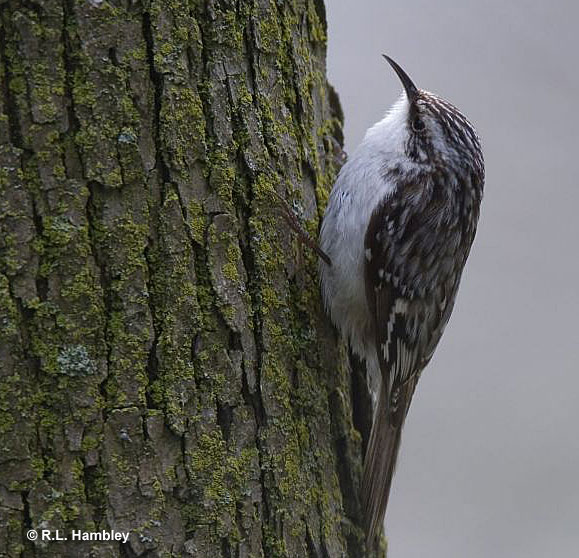
Female Brown Creepers look identical to male Brown Creepers.
Brown Creepers vary slightly in terms of their voice and color across their range. The most noticeable regional difference is the “Mexican” Brown Creeper, which inhabits New Mexico and southeastern Arizona. It’s usually darker on the back than Brown Creepers in other parts of their range.
Food
Brown Creepers consume larvae and insects during the breeding season. Some of the prey they’ll consume include fruit flies, stinkbugs, spider eggs, gnats, weevils, beetles, moths, butterflies, lacewings, scale insects, caddisflies, leafhoppers, flat-bugs, katydids, plant lice, sawflies, ants, pseudoscorpions, and spiders.
They mainly survey large trees that have bark that’s deeply furrowed. This kind of bark holds high amounts of insects. They probe, peck, and glean the trunks of trees with their downcurved, long bills. They start at the base of the trunk and make their way up until they’re several feet from the top.
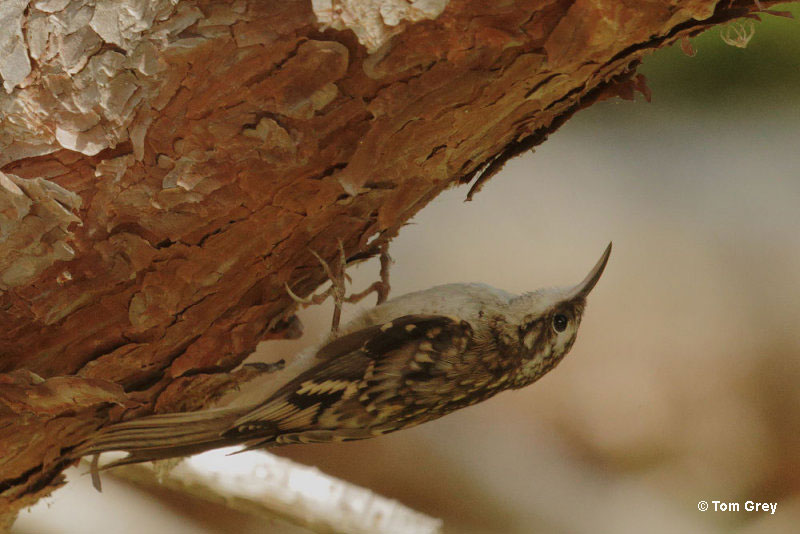
Once they reach the top, they’ll fly down to the base of another tree and start all over again. In the winter months, they have a similar diet but may also consume some plant materials and seeds.
If you have backyard bird feeders and would like to attract these birds to your yard, you’ll be happy to know that in the winter months, Brown Creepers will consume peanut butter, suet, sunflower seeds, corn, grass seeds, and pine seeds. You’re more likely to see them if your yard has old, large trees.
Nesting and Eggs
Both the male and female Brown Creepers of a mated pair will look into multiple possible nesting sites. They’ll usually choose a place between a piece of bark that’s loose and the trunk of a large tree. However, these birds sometimes nest in big live trees with dead portions or peeling bark. Nests are anywhere from 2 to 40 feet off of the ground.
The female is the one to build the nest, and it takes her a week or two to create the nest. The male does help by bringing her nesting materials. She’ll start by building the frame of the nest.
Then, she’ll layer strips of bark and twigs and uses spider egg cases and insect cocoons to stick the materials to the inner surface of the tree bark and each other.
The cup of the nest is around 2.5 inches tall and 6 inches wide. The nest cup will have spider egg cases, wood fiber, hair, grass, feathers, pieces of leaves, mosses, and lichens.
- The clutch size is 5 to 6 eggs.
- Brown Creepers have 1 brood per breeding season.
- Egg length is usually around 0.6 inches (1.5 to 1.6 centimeters).
- Egg width can be anywhere from 0.5 inches (1.2 centimeters).
- The incubation period is 13 to 17 days.
- The nestling period is 14 to 20 days.
- Brown Creeper eggs are smooth, white, and spotted with reddish-brown or pink.
Current Situation
Brown Creeper populations have been stable and marginally increased between the late 1960s and 2019. They have an estimated breeding population of 11 million.
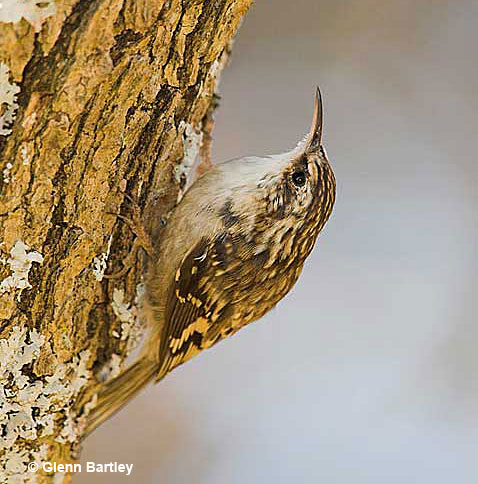
In the West, timber harvesting has removed many of the large trees that creepers forage in, and salvage logging has removed many dead and dying trees they nest in. In addition, forests are becoming increasingly fragmented, which poses another threat to Brown Creepers.
Their populations in New England have increased in recent years, this could be because forests have regrown. Additionally, Dutch elm disease and spongy moths have killed many big trees, creating nesting habitats for these birds.
The Brown Creeper prefers to inhabit forests with many big trees for foraging and nesting. In the summer months, they tend to live in mature coniferous forests in redwoods, ponderosa pine, Douglas-fir, spruce, bald cypress, white pine, and eastern hemlock.
In the winter months, Brown Creepers use a wider variety of habitats, from suburbs to deciduous forests to orchards to parks. Brown Creepers in the winter in north Texas and the Midwest are particularly common in tree savannas and oak-hickory forests.
Facts
- Brown Creepers in Arizona build their nests to have two openings. One opening serves as the entrance, and the other serves as an exit. Entrances face down and exits face up.
- A group of creepers is called a “sleeze” or a “spiral” of creepers.
- The Brown Creeper creates a nest that’s hammock-like. The nest is built on a dead or dying tree behind a loosened flap of bark. The unique nesting strategy wasn’t discovered until 1879.
Brown Creepers use stiffly pointed tail feathers to climb trees and easily support themselves against the trunk. - The oldest recorded Brown Creeper lived to be at least 5 years and 5 months old. It was initially captured during banding operations and was recaptured and rereleased in 2010 in Illinois.
Similar Species
The Brown Creeper has features that are similar to other bird species. Here are some similar species:
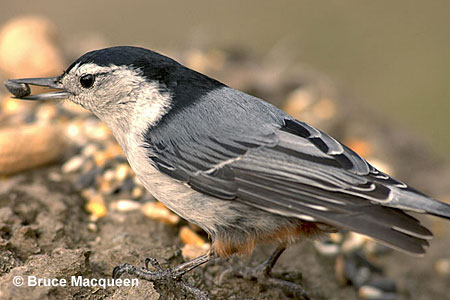
white-breasted nuthatch
Brown Creepers move up tree trunks, while Nuthatches usually move down.
Additionally, Brown Creepers have longer tails and lean on them for support. Nuthatches do not do this.
Nuthatches lack the streaky brown that Brown Creepers have and are much grayer on the back.
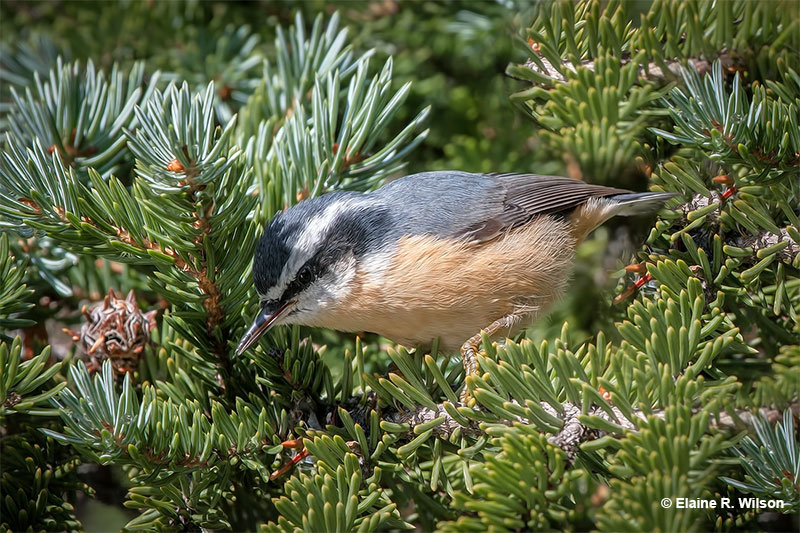
Red-breasted Nuthatch © Elaine R. Wilson
Brown Creepers have longer tails and lean on them for support. Nuthatches do not do this.
Nuthatches lack the streaky brown that Brown Creepers have and are much grayer on the back.
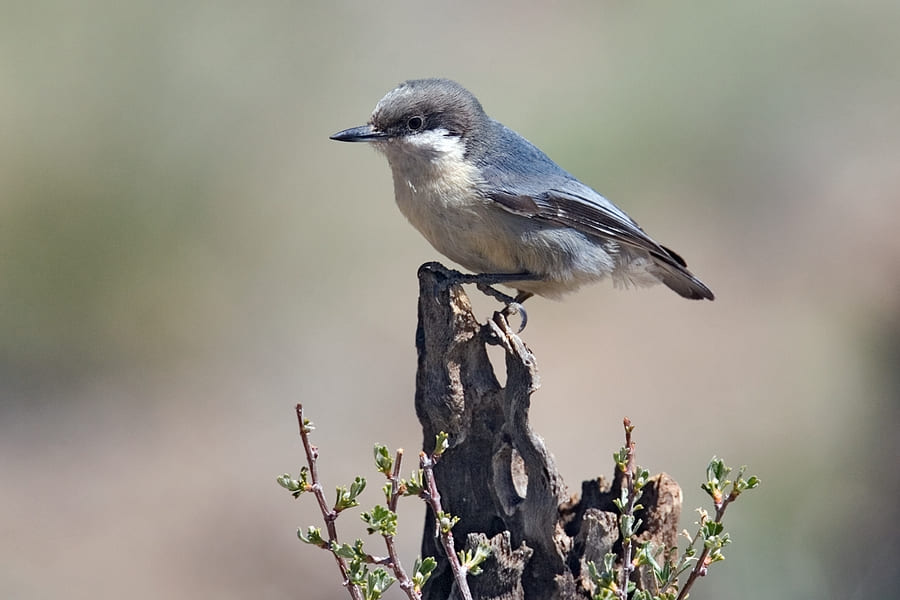
Pygmy Nuthatch
Brown Creepers have longer bills and streaks on the back that Pygmy Nuthatches don’t.
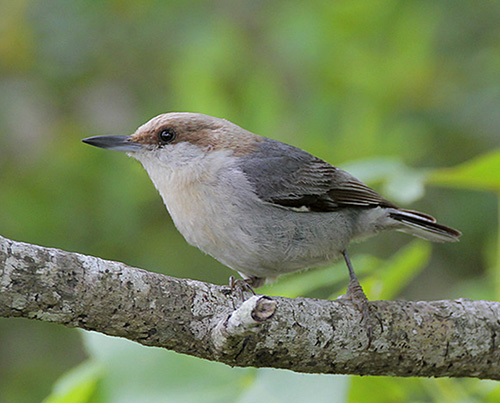
Brown-headed Nuthatch Photograph © Greg Lavaty.
The Brown-headed Nuthatches are grayer than Brown Creepers.
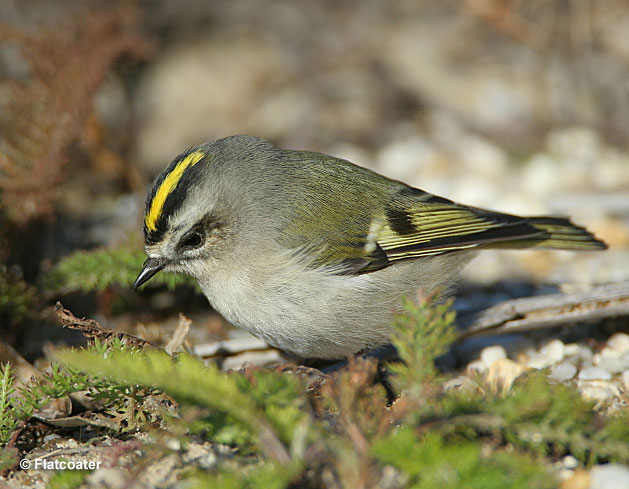
Golden-crowned Kinglet
Brown Creepers and Golden-crowned Kinglets don’t look alike, but their habitat and calls are very similar.
Brown Creepers have a call that wavers slightly descends and is longer than a Golden-crowned Kinglets call.
Additionally, Golden-crowned Kinglets repeat their call several times.
Frequently Asked Questions
Are Brown Creepers common?
Yes, Brown Creepers are common. Their estimated breeding population is 11 million, and can be found throughout most of North America, making them a widespread bird.
Where is the Brown Creeper found?
The Brown Creeper prefers to inhabit forests with many big trees for foraging and nesting. In the summer months, they tend to live in mature coniferous forests in redwoods, ponderosa pine, Douglas-fir, spruce, bald cypress, white pine, and eastern hemlock. In the winter months, Brown Creepers use a wider variety of habitats, from suburbs to deciduous forests to orchards to parks. Brown Creepers in the winter in north Texas and the Midwest are particularly common in tree savannas and oak-hickory forests.
What does a brown creeper look like?
Brown Creepers are buff and streaky brown above, with white underparts, brownish heads, and buffy wide stripes over the eyes. These birds are 4.7 to 5.5 inches (12 to 14 centimeters), weigh 0.2 to 0.3 ounces (5 to 10 grams), and have a wingspan of 6.7 to 7.9 inches (17 to 20 centimeters).
Where do Brown Creepers migrate to?
Brown Creepers are short-distance migrants and residents. Most Brown Creepers don’t migrate, but the ones that do are in the high-altitude and northern populations. They move south or in winter. Banding records show that Creepers from portions of Canada will sometimes go as far south as Arkansas and North Carolina.
Do Brown Creepers come to feeders?
Yes, they will sometimes come to bird feeders. In the winter months, Brown Creepers will consume peanut butter, suet, sunflower seeds, corn, grass seeds, and pine seeds. You’re more likely to see them if your yard has old, large trees.


